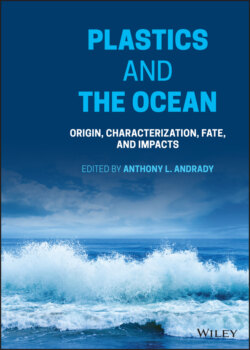Читать книгу Plastics and the Ocean - Группа авторов - Страница 59
2.5.3 Biotic Samples
ОглавлениеWithin biota studies, plastic additives were detectable in tissues from at least 134 species. The first sampling began before 1978 (Giam et al. 1978), and most studies have focused on fish, bivalves, and other invertebrates with a few studies addressing plants, turtles, birds, and mammals (Figure 2.7).
Attempting spatial and temporal comparisons in similar species for a particular compound class, other than PBDEs and HBCDs, is difficult because the published data is sparse. Past reviews have shown elevated levels of HBCDs in samples near chemical production or application facilities, indicating that some plastic additives are released directly into the environment instead of being leached from plastic products (Covaci et al. 2006). Several temporal trends show increasing BFR concentrations until approximately 2000, reflecting usage of the compounds in developed countries (Law et al. 2014). The continual increasing trends observed in the Arctic indicate their transportation to polar regions. For the other additive classes, fish offers the best sample type, but data are very limited after filtering the data for similar trophic level, habitat type, tissue analyzed, particular chemical reported in the same or convertible units, and summary statistic (e.g., mean or median). Filtering criteria are critical because additive concentrations can vary widely among fish species even from the same location (Gu et al. 2016), and additives do not distribute evenly throughout the body (Barboza et al. 2020). Filtered data available for comparison often include <20 individual fish from two or three locations on the global map and at different snapshots in time (Figure 2.8). It is not advisable to make global spatial generalizations with data like these.
Figure 2.6 An updated spatial comparison of mean concentrations of DEHP measured in marine surface waters from Asia, America, and Europe.
Figure 2.7 Distribution of plastic additive studies assessing different taxonomic groups.
Figure 2.8 Spatial comparison of bisphenol A mean concentrations in muscle tissue from mackerel and scad fish species.
Source: Data were taken from Gu et al. (2016), Basheer et al. (2004), and Barboza et al. (2020).
Note: Sample sizes are 1, 4, 5, 50, and 50 from left to right, respectively. Dotted bars indicate all fish were below the shown limit of quantification. Error bars indicate standard deviation or standard error provided in respective paper.
For human dietary intake studies, the tissue that is most frequently consumed (e.g. fillets) was analyzed. In trophic transfer studies, the whole fish was analyzed including the gastrointestinal tract which may contain ingested plastics. On fewer occasions, fish liver was analyzed and compared to muscle tissue for APs (Lye et al. 1999), bisphenols (Barboza et al. 2020), and also to gill and kidney for phthalates (Adeogun et al. 2015). Seabird eggs offer lipid‐rich samples suitable for long‐term monitoring programs (Law et al. 2014), and have been analyzed for additives beyond BFRs (Lundebye et al. 2010) and compared to liver concentrations (Hallanger et al. 2015). Likewise, marine mammal blubber is commonly analyzed for BFRs, because of their accumulation in fatty tissues. Blubber and plasma have been analyzed for benzotriazole UV stabilizers and for substituted diphenylamine antioxidants (Lu et al. 2016; Nakata et al. 2010). Phosphate‐based additive concentrations have been compared among the blubber, brain, kidney, liver, muscle, and plasma of marine mammals (Hallanger et al. 2015; Sala et al. 2019). Phthalate concentrations have been compared among sea turtle fat, gonads, liver, and muscle (Savoca et al. 2018), detected in seabird preen oil (Provencher et al. 2020) and in marine mammal liver (Rian et al. 2020). Since phthalates are quickly metabolized and eliminated from the body (Staples et al. 1997), some studies have targeted phthalate metabolites, instead of or in addition to the parent compound, in fish muscle (Fossi et al. 2014). Also, marine mammal blubber (Fossi et al. 2012), skin (Fossi et al. 2016), and urine (Hart et al. 2018, 2020) have also been studied in this regard. Urine concentrations of phthalates are the most widely used approach in human biomonitoring studies (Wang et al. 2019).
Certain additives can biomagnify in food webs, while others, like plastics themselves, do not (Covernton et al. 2021; Koelmans et al. 2016; Tomy et al. 2008). From our database, 12 studies investigated biomagnification of additives in marine food webs (see Box 1.2 in Chapter 1 for a discussion of biomagnification). Phthalates did not biomagnify significantly (Mackintosh et al. 2004; Morin 2003). Certain congeners of PBDEs biomagnified in several marine food webs (Brandsma et al. 2015; Mizukawa et al. 2009; Tomy et al. 2008), but conflicting results have been obtained for HBCDs (Brandsma et al. 2015; Tomy et al. 2008; Zhang et al. 2018c). One study provided evidence of TBBPA biomagnification (Li et al. 2021). Phosphate‐based FRs also did not biomagnify in three marine food webs but tentatively did in a benthic food web (Brandsma et al. 2015; Garcia‐Garin et al. 2020; Hallanger et al. 2015). There is some tentative evidence of biomagnification of benzotriazole UV stabilizers (Nakata et al. 2010; Peng et al. 2017). BPA most likely does not biomagnify (Corrales et al. 2015; Gu et al. 2016), and there is only weak correlative evidence for the biomagnification of 4‐t‐OP and 4‐n‐NP (Gu et al. 2016). We are unaware of trophic transfer studies for additive classes such as other antioxidants, heat stabilizers, fillers, IMs, colorants, or lubricants.
